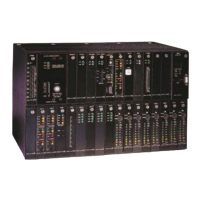Chapter 1. System Overview and Modes of Operation
30
Strobe Units
The Strobe Units activate the line card transmission paths (for transmit and receive) on the T1
digital bus by sending strobe signals corresponding to DS0 timeslots, to the line cards. The
strobed line cards then read and/or write to the T1 digital bus during the strobed period.
DS0 time slots and physical card slots are independent of each other; further, installing a line
card does not assign its transmission path within the D/I Mux III system. Mapping controls strobe
assignments, and the transmission path must be mapped. For more information on mapping,
refer to Chapter 4. Configuration and Operation.
Strobe signals are assigned and placed in software-configurable maps in both the CCU and
AMCU. The signals are downloaded to the Strobe units during system initialization and map
programming. Informational changes to a map are sent to the Strobe unit from the CCU. These
changes can include altering connections from line cards to time slots, or switching to another
configuration map. By changing to a new working map, the Strobe unit is able to change DS0
assignments without causing data errors on unaffected DS0s. The maps can be set to start in
response to a user-specified time, event, or keyboard entry.
High-speed Dual Synchronous Data Channel Unit (DSDCU), Digital Program Channel cards
(DPCs), and the Tandem Access Unit (TAU) can require more than one strobe, and can move a
greater amount of data on one circuit.
The Upper Strobe unit (P/N 30307-101 or 30307-103) is functionally equivalent to the Lower
Strobe unit (P/N 30307-102 or 30307-104A). The Upper Strobe is used only for the D/I Mux III
24-slot shelf, and provides transmission control for the line cards in the top half of the shelf. The
Lower Strobe unit provides transmission control for the line cards in the bottom half of a 24-slot
shelf, and for 8-slot and 12-slot shelves.
Strobes perform the following functions:
• Provide transmission control of the line cards
• Store map configuration data when power is on (the CCU and AMCU store maps during
power-off)
• Change maps as required by event, time, or demand
Map Select Option Switches
DIP switches on the Lower Strobe unit can be used to manually select a preconfigured
map. Eight different maps are available to load into one map location (e.g., map number
1) after power-up and initialization (see Appendix D. Preconfigured Maps.) The switches
on the Upper Strobe unit do not affect map selection.
Initialization
On power-up, the Strobe units perform a diagnostic check of program memory, operating
Random Access Memory (RAM), and dual-port map RAM. The Strobe units also receive
map configuration data from the CCU and AMCU.
Figure 1-13, following, is an illustration of a strobe unit block diagram.

